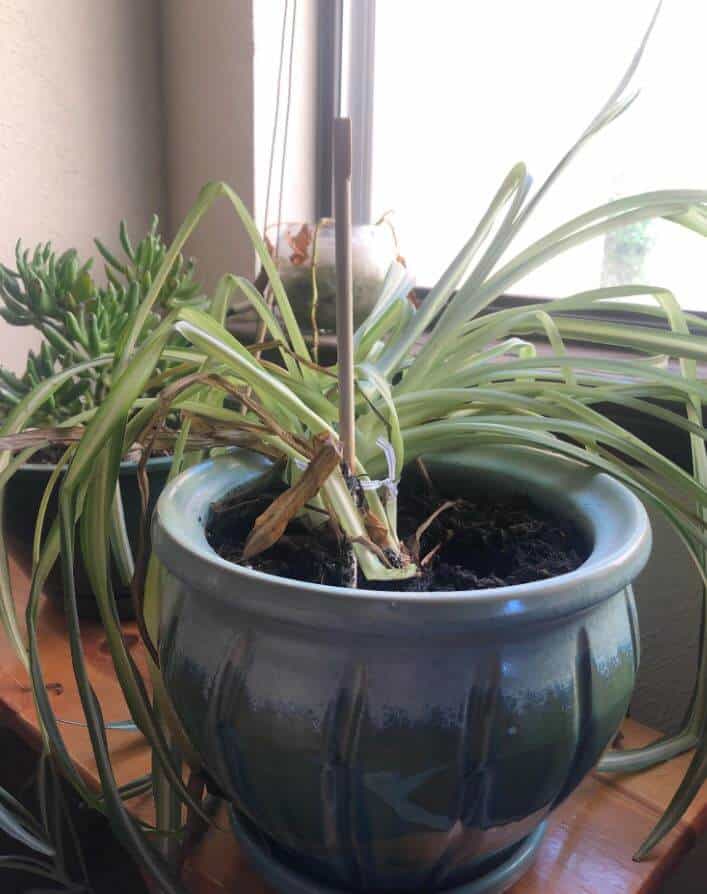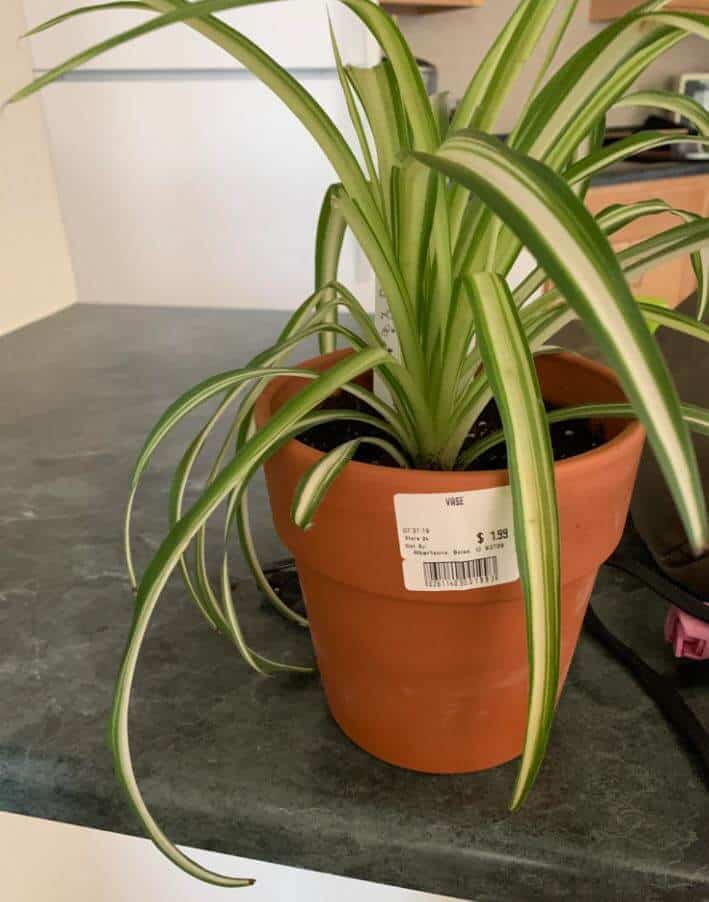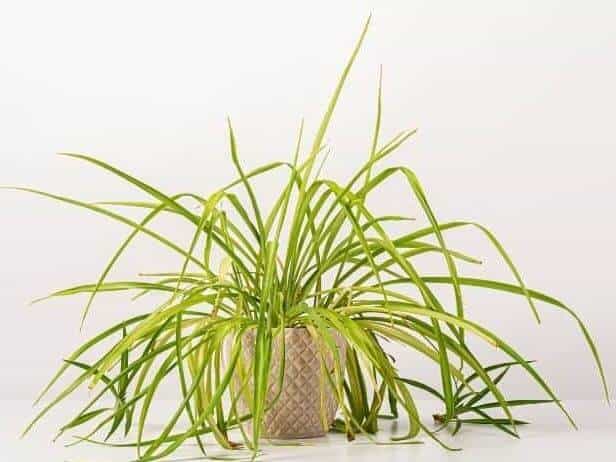Last Updated on September 9, 2023 by a Friendly Gardener
Spider plants, known for their graceful arching foliage and easy maintenance requirements, are incredibly popular in offices and homes around the globe. But what does it mean when leaves bend, perhaps even breaking, instead of arching elegantly?
The foremost cause of bending foliage as opposed to graceful arching is improper watering. Both underwatering and overwatering can create bending problems for this delightful houseplant. A lack of sufficient light can also cause Spider plant leaf bent, so let’s consider the most often found causes and what you can do to remedy the situation.
Common Causes of Spider Plant Leaf Bent

Improper Watering
Summertime sees an increase in bending leaves that generally happens because of insufficient water. Summer temperatures bring excessive heat and consequentially quicker evaporation of moisture available to plants. If your plant is not getting its moisture needs met, the foliage will begin to bend.
The opposite problem of overwatering will also cause leaf bent, so it’s important to evaluate how much water and how often your plant needs it. If you feel your plant is suffering from dryness and then proceed to overwater it, the foliage will continue bending unabated. But overwatering will not only cause leaf bent, but it can also lead to root rot and the death of your plant as well.
Plan on watering your Spider plant weekly in the summer and once every two weeks in the winter. Ideally, you will want to check your plant’s soil bed to judge if this is the best choice for your plant and your climate. When the top one to two inches dries out, give your plant a nice soaking or thorough watering. Also, keep an eye on drainage holes to make sure they are not clogged and draining properly. If you have doubts, get a moisture meter.
Indoor humidity for the Spider plant should measure 50% or above.
Insufficient Light
Direct sunlight exposure threatens severe harm to Spider plant leaves, so many home gardeners will look for a shady or protected spot to keep their plants healthy. Unfortunately, the Spider plant thrives in indirect bright light, so keeping it in low light conditions will also cause leaves to bend.
Consider the season when finding the correct location for your plant. Summer sunlight can be harsh and scorch leaves. Winters may provide insufficient lighting. You may want to change your plant’s location depending on the season to ensure adequate light without exposing it to direct harmful UV rays.
A windowsill in the winter may be fine while in the summer it may be too much. If your plant is in a low-light environment, consider using a grow light to guarantee your plant ample indirect bright light.
Incorrect Feeding

One of the risks associated with fertilizing a plant is overfeeding. An excess of nutrients can create toxicity. This, however, does not suggest that your plants should not be fed. Should your Spider plant not receive all the necessary nutrients from the soil bed, a lack of nutrition can also cause leaf bending.
Finding the correct fertilization balance is crucial to your Spider plant’s well-being. Both underfeeding and over-fertilization will harm the plant. The type of fertilization you apply is equally important. If you are fertilizing correctly and your plant is still experiencing leaf bending, consider whether there is a nitrogen deficiency. Nitrogen is vital to new foliage growth in plants. You may want to look for a fertilizer that has a higher nitrogen content.
You can reduce fertilization or avoid feeding in fall and winter. Spider plants will grow very slowly in the cooler season. When spring arrives, begin feeding your plant monthly during its growing season. Select an organic fertilizer with a 20-20-20 NPK ratio and dilute it to half of the recommended amount. If your plant shows signs of needing more, you can adjust accordingly or apply a fertilizer that has a higher nitrogen content.
Remember to flush your plant every three to four months t eliminate any salt buildup in the soil from fertilization.
Pest Infestation
If watering, light, and fertilization are correct, look for signs of a pest attack. Sap-sucking pests like aphids or spider mites may be guilty in the event of leaf bending. These pests suck the vital sap of the plant, feed from it, and cause considerable damage. At a first glance, they may not be visible. Spider mites will leave signs of webbing underneath leaves while aphids will be visible upon close inspection.
Give your plant a shower to remove the pests and then treat it with either insecticidal soap or Neem oil to eliminate any remaining insects. If plant parts are severely affected, prune those parts off.
The Wrong Container

Containers can make a huge difference in how much a plant will thrive. If a pot is too small, your plant will become root bound and roots will begin to emerge from drainage holes and the soil bed. If, on the other hand, your plant’s pot is too large, this can contribute to the soil becoming waterlogged and soggy leading to leaf bending.
Plan on repotting your Spider plant at least once every two years to allow added room for growth and development. Select a pot that is one to two inches larger.
Spider Plant Broken Leaves

Spider plant leaves break for many of the same reasons for leaf bent. Improper watering, improper sunlight, and pests can also cause Spider plant broken leaves. Additional causes include:
-
Soil Bed Acidity
A Spider plant requires a soil pH that is somewhat alkaline measuring between 6.1 and 6.5. Use a soil pH test to verify if the soil pH is correct.
-
Water quality
Houseplants react to chemicals in the water, so chemicals in tap water can cause leaf breakage. If you cannot identify other causes for leaf breakage, consider the quality of your tap water. Consider using filtered, distilled, or collected rainwater for your plant.
-
Root Rot
Spider plant broken leaves can also be symptomatic of root rot. If brown spots appear on foliage that subsequently breaks, your plant may have a case of root rot. A foul smell emanating from your plant’s soil is another indication to watch for. You will need to repot your plant and prune away any infected roots during the transplanting of the Spider plant.
Should Spider Plant Broken Leaves Be Pruned?

Pruning broken leaves will allow your plant to channel nutrients to healthy foliage. However, pruning improperly can harm your plant. Broken leaves will not heal and will not regenerate, so there is no need to leave them on your plant. Pruning broken leaves will improve your plant’s appearance, improve nutrient flow, and prevent diseases or pests from spreading to remaining healthy foliage.

